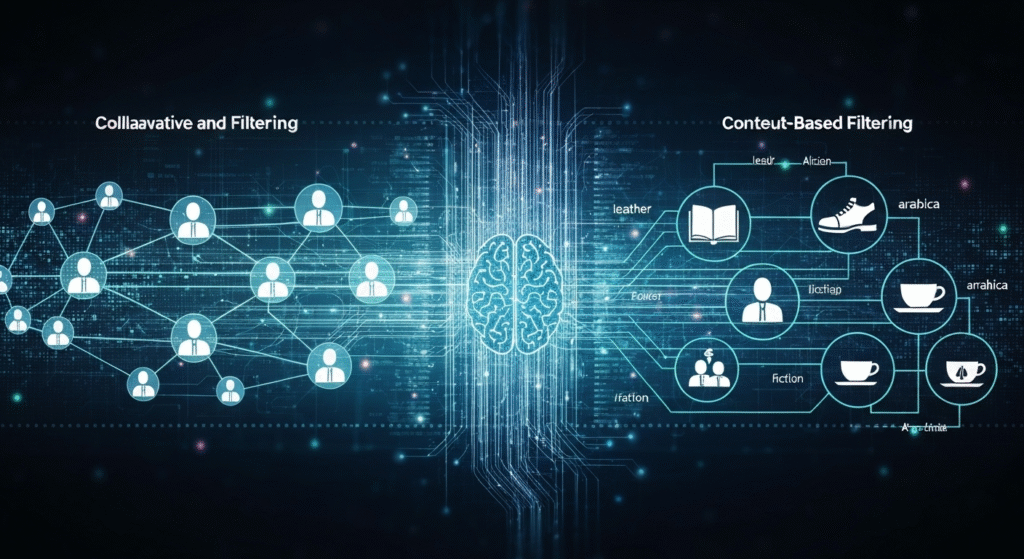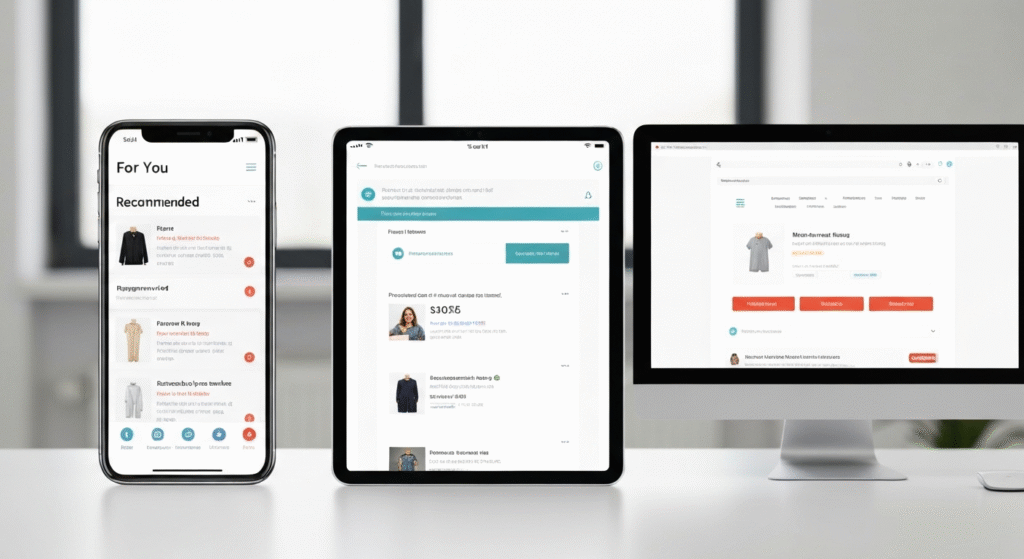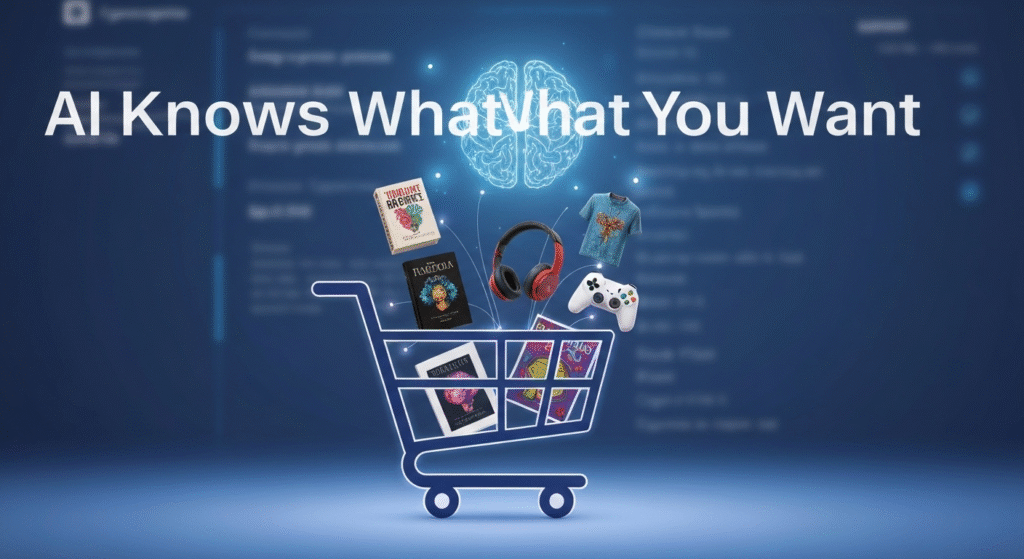Have you ever browsed for a new pair of headphones on a shopping site, only to see ads for those exact headphones following you across the internet? Or maybe you’ve logged onto your favorite online store and the homepage seems to be filled with products you were just thinking about. It can feel a little strange, like the website is reading your mind. The truth is, it’s not magic; it’s a powerful and complex application of Artificial Intelligence designed to create a shopping experience tailored just for you. This technology is the invisible force behind a personalized and seamless online journey.
My name is Zain Mhd, and for the past five years, I’ve been working professionally in the AI space. I’ve had the chance to see behind the curtain of systems like these, exploring how data is used to build predictive models that shape our digital world. As someone who has spent years writing about and researching AI, I’ve become fascinated by how these complex algorithms translate our clicks and searches into a personalized storefront. It’s this curiosity that drives me to demystify the technology that’s becoming a bigger part of our daily lives, explaining it in a way that’s clear and easy to understand.
Understanding E-Commerce Personalization

At its core, e-commerce personalization is the process of creating a unique shopping experience for each individual visitor. Instead of showing every person the same generic homepage, product lists, and offers, the website uses AI to dynamically adjust the content based on who you are and what it thinks you want. Think of it like the difference between walking into a massive department store versus a small boutique where the owner knows your style, remembers your last purchase, and can recommend something new you’ll probably love.
The goal is twofold. For you, the shopper, it makes finding what you need faster and more enjoyable. You don’t have to sift through hundreds of irrelevant items. For the business, a personalized experience leads to happier customers who are more likely to make a purchase. Research consistently shows that customers are more likely to buy from brands that offer a personalized experience. A report from McKinsey found that personalization can lift revenues by 5-15% and increase marketing spend efficiency by 10-30%. It’s a powerful tool that has fundamentally changed the landscape of online retail.
The Core AI Engines: How the Magic Actually Happens

The “mind-reading” ability of e-commerce sites isn’t one single technology, but rather a combination of different AI models working together. Two of the most foundational methods are collaborative filtering and content-based filtering. While they sound technical, the ideas behind them are quite simple.
Collaborative Filtering: Learning from the Crowd
This is the engine behind phrases like “Customers who bought this also bought…” It works on a simple, very human principle: people with similar tastes tend to like similar things. The AI doesn’t need to understand the products themselves; it just needs to find patterns in user behavior.
Let’s break it down with an analogy. Imagine you and your friend Sarah both love action movies. You’ve both watched and enjoyed Die Hard, The Terminator, and Mad Max: Fury Road. One day, Sarah tells you she just watched a new movie called The Gauntlet and loved it. Based on your shared history, there’s a very high probability that you will enjoy The Gauntlet too.
Collaborative filtering does this on a massive scale. It looks at your purchase and browsing history and compares it to millions of other users to find a group of “digital neighbors”—people who have bought and viewed similar items. It then looks at what those neighbors bought that you haven’t seen yet and recommends those items to you.
| Feature | How It Works | Real-World Example |
| Core Idea | Finds users with similar tastes and recommends items they liked. | Amazon’s “Customers who viewed this item also viewed” section. |
| Data Required | User interaction data (ratings, purchases, clicks) from many users. | Your history of buying certain brands of coffee. |
| Strength | Can recommend diverse and unexpected items you might not have found otherwise. | Recommending a fantasy novel to someone who only buys sci-fi, because other sci-fi fans also liked it. |
| Weakness | Suffers from the “cold start” problem. It doesn’t work well for new users or new products with no interaction data. | A brand-new product on a site won’t be recommended until enough people have bought it. |
Content-Based Filtering: It’s All in the Details
Where collaborative filtering looks at other people, content-based filtering looks at the products themselves. This method is built on the idea that if you like a particular item, you are likely to enjoy another item with similar attributes. It’s the driving force behind recommendations like “More from this brand” or “You might also like…” if you’re looking at a specific type of product.
The AI analyzes the “content” or attributes of the items you interact with. For a movie, these attributes could be the genre, director, lead actors, and plot keywords. For a shirt, it might be the brand, color, material, and style (e.g., v-neck, long-sleeve). When you buy a blue, cotton, v-neck t-shirt from a specific brand, the system creates a profile of your preferences. It then searches its inventory for other items that match these attributes—other blue shirts, other cotton apparel, or other items from that same brand—and recommends them to you.
This method is excellent for providing recommendations that are highly relevant to your immediate interests. However, it can also create a “filter bubble,” where you are only ever shown things that are very similar to what you’ve already seen, making it harder to discover new and different products.
The Hybrid Approach: The Best of Both Worlds
As you might guess, neither of these methods is perfect on its own. That’s why most sophisticated e-commerce platforms, like Netflix and Amazon, use a hybrid approach. They combine collaborative and content-based filtering to leverage the strengths of both while minimizing their weaknesses.
A hybrid system might use content-based filtering to get a handle on a new user’s tastes. For example, when you first sign up for a streaming service, it might ask you to pick a few movies you like. It can then use the attributes of those movies to make some initial recommendations. As you watch more content and the system gathers more data, it can start incorporating collaborative filtering to introduce you to new shows that people with similar viewing habits have enjoyed. This combination provides both relevant and novel recommendations, creating a much richer experience.
The Data That Fuels the AI
An AI model is only as smart as the data it’s trained on. E-commerce personalization engines are constantly collecting and analyzing different types of data to build and refine a profile of your preferences. This isn’t just about what you buy; it’s about your entire digital footprint on the site.
Browsing History and Clicks
Every action you take on a website is a signal. The AI tracks:
- Products you view: Which items did you click on from a category page?
- Time on page: Did you glance at a product for two seconds or spend five minutes reading reviews? More time suggests a higher level of interest.
- Search queries: The exact words you use to find products reveal your immediate needs and preferences.
- Items you add to your cart or wishlist: This is a very strong signal of desire, even if you don’t complete the purchase.
This data helps the AI understand your current shopping intent and build a short-term profile of what you’re looking for right now.
Purchase History
Your purchase data is the most valuable information for personalization. It’s a direct confirmation of your preferences, size, and style. The AI looks at:
- What you bought: The exact products, brands, and categories.
- How often you buy: Are you a frequent shopper or a seasonal one?
- Average order value: Do you tend to buy premium items or look for deals?
This information helps build a long-term understanding of you as a customer, allowing the site to predict what you might need in the future. For example, if you buy a three-month supply of dog food, the site’s AI might send you a reminder email with a coupon about 11 weeks later.
Demographic and Geographic Data
This is broader information about who you are and where you are. It can include your age and gender (which you might provide when creating an account) and your location (inferred from your IP address). This data is used for high-level segmentation. A retailer won’t try to sell swimsuits to someone in a cold climate in the middle of winter. Instead, they’ll use geographic data to promote winter coats and boots to that person.
Personalization in Action: Where You See It Work

This combination of AI models and data manifests in several ways that you likely encounter every time you shop online.
| Type of Personalization | Description | How AI Is Used |
| Product Recommendations | Sections like “For You,” “Top Picks,” and “Inspired by your browsing history.” | Hybrid models use both your past behavior (content-based) and the behavior of similar users (collaborative) to populate these lists. |
| Dynamic Content | The very layout of a homepage can change for different users. | The AI prioritizes and displays banners, categories, and promotions based on what it predicts will be most relevant to you. |
| Personalized Emails | Emails about abandoned carts, price drops on items you viewed, or new arrivals from brands you like. | The system uses your real-time browsing data to trigger automated but highly personalized marketing messages. |
| Targeted Ads (Retargeting) | Ads for products you recently viewed that appear on other websites and social media. | Your browsing data is used to create an audience for ad platforms, ensuring the ads you see are for products you’ve already shown interest in. |
| AI-Powered Search | Search results on an e-commerce site are sorted differently for each user. | The AI re-ranks search results to show products from brands you’ve bought before or styles you’ve clicked on more frequently at the top. |
The Balance Between Personalization and Privacy
There’s no denying that this level of personalization can be incredibly convenient. It cuts through the noise of the internet and helps us find what we want more easily. However, it also raises important questions about data privacy. The feeling of being “followed” by ads can be unsettling, and many people are understandably concerned about how much information companies are collecting about them.
It’s a trade-off: we exchange our data for a more convenient and tailored experience. Here’s the thing, this exchange is becoming more transparent. Regulations like the General Data Protection Regulation (GDPR) in Europe and the California Consumer Privacy Act (CCPA) are giving consumers more control over their data. These laws require companies to be more transparent about what data they collect and give you the option to opt out. As users, being aware of how this technology works is the first step in making informed decisions about our data.
Frequently Asked Questions
1. Is my phone listening to my conversations to show me ads?
This is a common concern, but there is no concrete evidence that phones are actively listening to conversations for ad targeting. It’s more likely that the uncanny accuracy comes from the vast amount of data the AI has from your clicks, searches, location, and connections with other users who have similar interests.
2. Can I turn off this personalization?
Most platforms offer some level of control. You can often clear your browsing history on the site, manage your ad preferences on platforms like Google and Facebook, and decline cookies when you visit a new website. This can reduce the amount of personalization, but it may not eliminate it entirely.
3. How is this different from a regular TV or billboard ad?
Traditional advertising is a one-to-many approach; everyone sees the same ad. AI-powered personalization is a one-to-one approach. The ads and content are tailored specifically to your individual profile, making them far more relevant than a generic billboard.
4. Do all online stores use this kind of advanced AI?
While the largest retailers like Amazon have very sophisticated, custom-built AI systems, many smaller online stores now have access to this technology through platforms like Shopify and BigCommerce, which offer personalization apps and tools. The level of sophistication can vary, but the basic principles are becoming widespread.
Conclusion
The next time an online store recommends a product that feels perfect for you, you’ll know it’s not a coincidence. It’s the result of complex AI systems working silently in the background, analyzing patterns in data to act as your personal digital shopper. By understanding your past actions and comparing them to millions of others, these algorithms can make remarkably accurate predictions about what you might want or need next.
This technology has transformed e-commerce from a static catalog into a dynamic, responsive, and deeply personal experience. While the balance between convenience and privacy continues to evolve, there’s no doubt that AI-powered personalization is here to stay. Understanding how it works allows us to be more informed digital citizens, appreciating the convenience while being mindful of the data that makes it all possible.

